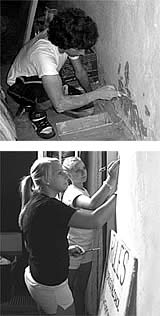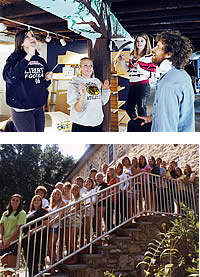
by Jordan Denari
BETHLEHEM, PA—During the 1960s, a teacher and students at Liberty High School in Bethlehem, Pennsylvania attempted to restore an old grist mill. They succeeded in converting Illick’s Mill into the region’s first music venue for teenagers. But as the years went on, the mill on the banks of Monocacy Creek fell into greater disuse and disrepair.
In 2001, Karen Dolan, another Liberty High School teacher, decided to use the run-down mill as an educational opportunity for her students and the community.
The area was in need of an environmental education center, and the mill, which sat on a 28-acre nature preserve, seemed to be the perfect place to build one.
Jeff D’Arcy is a senior at Liberty and is in his second year participating in the Illick’s Mill Project. He was motivated in part to join because of his older sister, who was also a part the non-profit organization through the high school.
The main objective of the project, he explains, is “completely restoring Illick’s Mill to make it into an environmental center.” Other major goals are “reaching out to elementary and middle school students...and educating the community,” along with rehabilitating the surrounding nature preserve.
Another student participant is Niharika Pendurthi, a junior who was attracted to the organization’s professional atmosphere.
After a rigorous application process, the students become employees of the non-profit. But rather than making money, they are rewarded with English and History credits to fulfill course requirements. Students in the project spend one-and-a-half to three hours of “class time” working for the organization each day.
After the mill’s grand opening in October, the students transferred their class time to the mill permanently.
A permanent classroom
“We really appreciate coming to the mill everyday because it’s not a stuffy classroom--we’re not doing boring work,” Niharika says. “I find that I get so much done here as opposed to doing it in a school setting, because it’s also a lot more relaxed and a lot less pressurized.”
Karen Dolan, the project’s Executive Director, assigns students individual or group tasks, based on their interests and talents. Students are split into different specialized committees--Corporate Development, Design and Technology, Membership and Events, Community Relations. It is the students’ sole responsibility to complete their respective jobs, like planning fundraising events, increasing community support, and repairing the mill.
No matter the committee, every student writes. Students are assigned to write grants, along with their other work. The class of 2007-2008, which included Jeff’s older sister, wrote 99 grants during that year. 
“In honors classes at school I’ve never written a paper as strenuously or as efficiently [as the grant I wrote],” says Niharika.
The writing has paid off. The organization has succeeded in raising approximately $1 million to fund their projects.
In 2004, the students succeeded in getting Illick’s Mill placed on the National Register of Historic Places. They are the first high school group to ever achieve this distinction.
Jeff recalls the Illick’s Mill grand opening, when the ribbon on the front door was cut. All of the time and dedication he and his sister put into the project had proven worthwhile.
“[The Mill] is a symbol of environmental protection that will last forever and I know I’ve had a part in helping restore that mill,” Jeff says. “I’ve seen it from a building that you wouldn’t really want to walk into turn into an amazing building that I look forward to walking into everyday.”
After being a member of the Corporate Development team, Jeff plans to study business and marketing in college next year.
Niharika’s participation in the project has greatly affected how she lives her daily life today.
“I would consider myself now changed even in my practices regarding recycling as well as conservation of energy, as well as just thinking twice before I throw something out instead of washing it out and throwing it into the recycling bin.”
And she recognizes the value of this non-traditional classroom experience.
“Truthfully, I think that this classroom is a lot more practical than a lot of the things I’ve been doing in a traditional setting. I’m taking every skill that I’ve built up from kindergarten to eleventh grade and now I’m actually doing something with it. It requires you to grow up a little bit and take on new responsibilities outside of the comfort of a classroom.”




